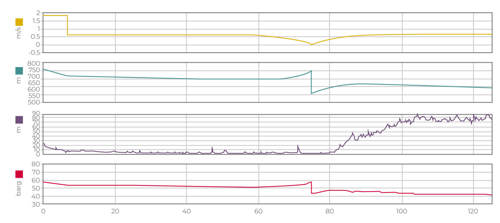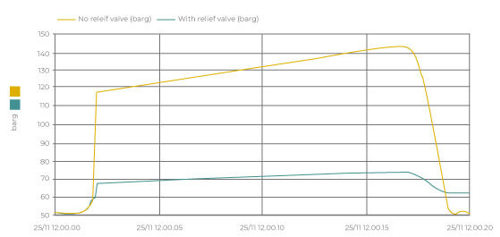Rapid transients, surge analysis and the speed of sound
Rapid transients are often seen as a specialty in their own right. Expert consultants dedicate their careers to rapid transients, conducting surge analysis for pipeline simulation. The timescale at which rapid transients take place is distinctly different to the operating scenarios mentioned in optimizing operations using a pipeline simulator and added with the fact that speed of sound is different in pipelines it makes for a very interesting topic to look at further.
Safety first
Every pipeline has a start-up sequence and an emergency shut-down procedure but both are easy to get catastrophically wrong. For example, what happens if something happens too suddenly or too gradually?
An action that may seem safe could have unintended knock-on effects elsewhere in a complex pipeline network.
For this reason, the control systems and procedures governing how a pipeline must be operated are carefully designed and strictly abided by. Their logic is represented in pipeline simulation software, which offers scenarios including not just what happens in start-up and shut-down, but also the consequences of a leak, blow-down, pressure relief and choked flow.
Speed of sound
Speed of sound is slower in a fluid moving through a pipeline than if that exact same fluid existed outside a pipeline. Fluid moving outside a pipeline operates at free sound speed, so it’s only governed by two properties: its isentropic bulk modulus (Bs) and density (ρ).
Sound speed for a pipeline fluid involves additional metrics to perform a corrected calculation that take pipe properties into account:
- Inner diameter (D)
- Elastic modulus (B)
- Wall thickness (δ)
- Restraint factor (ϕ)
For thin-walled pipes, the calculation for the corrected speed of sound would look like this:

To minimize potential flow interruptions, further calculations like the Joukowsky equation are necessary to ensure safe pipeline operations can be conducted by simulation software like Atmos SIM.
Pressure surge
Here we’ll provide a breakdown of a possible surge scenario called a pressure surge and how the active, passive and automated mitigation strategies of a surge analysis with pipeline simulation can improve pipeline operations.
When fluid in a pipeline is subjected to an inappropriate change in velocity, pressure surge, also known as water hammer or hydraulic shock, occurs.
This phenomenon is typically caused by poor control of a pipeline, such as during emergency shut-down procedures (ESD). After a power failure for example, a priority of the ESD involves quickly ceasing flow by closing valves, but when this is done by closing valves with the force of reverse pressure gradients it presents a risk of reverse flow in a pipeline. This can be costly if reverse flow escalates into a pressure surge.

Figure 1: The instant of a valve closure within a flowing liquid pipeline. A surge travels in the upstream direction and another travels downstream. The top profile is of flow velocity, the second is of head, the third is elevation and the bottom is pressure
Because pressure surge can cause catastrophic accidents, surge analysis is required to ensure that pipeline operations avoid creating any hydraulic transients that exceed safe operating limits (SOL).
Specialist consultants are employed to size surge relief equipment and assess fast-acting logical strategies to protect against worst-case scenarios such as pipeline leaks or ruptures. Their work is facilitated by pipeline simulation suites such as Atmos SIM, with closely spaced knots and time steps suitably short in duration.
The Joukowsky equation is beneficial in the event of a pressure surge because it enables pipeliners to track peak transient pressure in their pipeline. An example of this could be during an instance like figure 1 when a valve is closed suddenly. Surge analysis paired with calculations like the Joukowsky equation ensure pipeliners can implement the most appropriate surge mitigation strategies, whether they be active, passive or automated.
Active surge mitigation strategies
Calculating a pressure surge enables pipeline designers to install devices and procedures for mitigating hydraulic surges which are safety critical and can be relied upon to mitigate the catastrophic consequences of a pressure surge.
If we take the example of a valve being slammed shut at the outlet of a short crude oil pipeline, the pipeline will rupture, but a surge analysis performed by a user-friendly pipeline simulator such as Atmos SIM can determine whether the surge exceeds the line’s maximum head. These insights can be used to determine whether a surge mitigation procedure (active surge mitigation) or a surge relief device (passive surge mitigation) is needed in the pipeline.
Passive surge mitigation strategies
Passive surge mitigation devices like relief valves are safety critical so it’s vital that pipelines use good standards and practices to ensure they operate at the right time and at the right pressure.

Figure 2: Pressure upstream of a one second valve closure, with (green) vs without (red) a pressure relief valve positioned immediately upstream of the closing valve
Another example of a surge mitigation device is a surge tank, which can mitigate both up-surges and down-surges. If a line pressure exceeds the SOL, liquid is diverted into the tank which reduces the height of the pressure surge and if pressure falls below the tank pressure, liquid flows out of the tank and increases the pressure at the trough.
Automated surge analysis
It’s vital that every change to a pipeline’s characteristics, material specifications or fluid properties receives a detailed surge analysis. Automated surge analysis can be facilitated by solutions such as Atmos SIM, which includes the following features:
- Variable knot spacing
- Variable time-steps
- Reverse velocity modeling for dynamic check valve behavior
- Pump modeling for accurate spin-up and spin-down behavior
- Control logic for simulating control during surge events
- Valve characteristic inputs for accurate valve closure
Using these capabilities, Atmos SIM can automatically launch surge scenarios in succession. It produces a report summarizing key results including the peak surge pressure and its location. The reporting also outlines important results in a convenient format for scrutiny and generates trends for each pressure surge scenario.
Run your pipeline safely and cost effectively
Under potentially emergency situations, such as the impacts of a surge scenario, pipeliners’ actions can be critical to the safe operation of pipelines.
Surge analysis together with pipeline simulation helps pipeliners respond quickly to ongoing changes, maintain safe pipeline operations and avoid the costly effects of unmitigated surges.
References
1 “The Atmos Book of Pipeline Simulation”
Download chapter nine Order the book
Ready for chapter 10?
Chapter 10 covers how real-time transient modelling can be an effective leak detection system that detects leaks quickly and accurately estimates their location and size.
